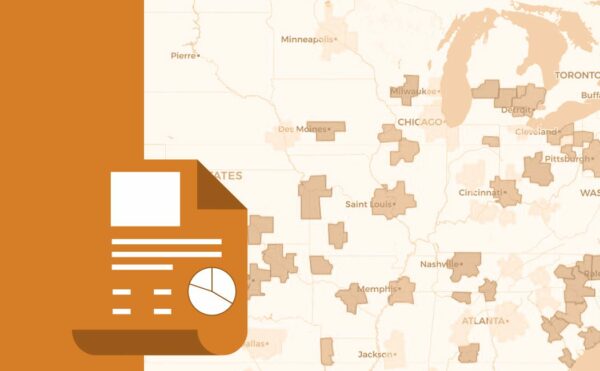
November 8, 2022
Originally published via UrbanLand
Real estate economists offered a less optimistic forecast of the near-term U.S. real estate and economic environment compared with six months ago, downgrading predictions for a wide range of economic, capital market, and real estate variables. Some of the biggest changes to forecasts included 2023 gross domestic product (GDP), job growth, and private real estate returns, according to the Fall 2022 ULI Real Estate Economic Forecast. That said, real estate market forecasts are in no way dire, with positive returns and mostly positive rent growth throughout the forecast period.
While many of the variable-specific forecasts are still positive and, in some cases, better than long-term averages, the difference between the recent fall forecast and the spring 2022 forecast is striking. Looking at the 2023 forecasts, of the 27 variables covered by the fall forecast, 23 were more negative than six months ago, three were the same, and only two—real estate investment trust (REIT) and hotel occupancy—were more positive.
This turnaround is not surprising given that the U.S. economy turned in two quarters of negative economic performance during the first half of the year, inflation has remained stubbornly high, the Federal Reserve has raised base interest rates at an unprecedented rate, and stock and REIT prices are down more than 25 percent since the start of the year.
The Real Estate Economic Forecast, produced by the ULI Center for Real Estate Economics and Capital Markets, is based on a survey conducted in September and October of 2022 of 43 economists and analysts at 37 leading real estate organizations. The forecast is based on the median responses gathered in the survey, which reflect a wide range of views both better and worse.
Key Findings for Commercial Real Estate
The total return from unleveraged core real estate (NCREIF Property Index or NPI) is forecast at 9 percent in 2022, down marginally from the 10 percent predicted six months ago. A much larger adjustment was made to the 2023 NPI forecast, down over 4 percentage points to 3.8 percent in the current survey. The downturn will be short lived—NPI total return is forecast to be 7 percent in 2024, the same as the prior forecast.
Economists predict that U.S. real estate transaction volumes will fall to $600 billion in 2022 and 2023 (down from a record $855 billion in 2021), before rebounding to $750 billion in 2024. The 2022 and 2023 forecasts are down from six months ago but well above the long-term average of $427 million, implying relatively strong capital market activity. Commercial mortgage–backed security (CMBS) debt availability will also subside from the 2021 level of $111 billion. Issuance is projected to be $80 billion in 2022, $85 billion in 2023, and $100 billion in 2024. While the first two years are lower than last spring’s predictions, all years are close to or above the long-term average of $83 billion. While publicly issued real estate debt is forecast to be generally available, there are concerns about availability from private sources such as banks and insurance companies.
Commercial real estate prices, as measured by the RCA Commercial Property Price Index (CPPI), are projected to rise by 5.5 percent in 2022, 3.0 percent in 2023, and 5.0 percent in 2024. All of these forecasts are lower than the spring results, with 2023 the lowest growth rate since 2010.
Returns will vary widely by property type. Focusing on 2023 and 2024 (2022 is largely in the books), average returns will range from 8.8 percent for industrial to 1.8 percent for office, with apartments at 6.5 percent and retail at 5.0 percent. Office is expected to have one year of negative returns (–0.6 percent in 2023), while forecast returns for all other property types/years are positive. Forecast returns for equity REITs are –20.5 percent in 2022 and 10.0 percent in 2023 and 2024. Six months ago, REITs were forecast to return 8.0 percent in 2022, indicating how sharply public capital markets have changed over that time frame.
More Urbanland ULI Forecasts
Despite slower economic growth, industrial/warehouse rent growth is forecast to average 4.5 percent during 2023 and 2024, still strong in relation to the 20-year average of 1.8 percent. The industrial availability rate will increase slightly to 5.3 percent, well below the long-term average of 9.6 percent. The apartment market will also weather the slowdown well. The forecast 2024 vacancy rate of 3.7 percent is 140 basis points lower than the long-term average (5.2 percent). Apartment rent growth is predicted to average 3.3 percent over the 2023–2024 period.
Prospects for neighborhood and community centers are surprisingly positive, given all of the negative press that the retail sector has been receiving since the onset of COVID-19. The availability rate forecast for neighborhood and community centers is 7.7 percent each year from 2022 to 2024, lower than the 2019 (pre-COVID) rate of 8.5 percent. Rents will grow by an average of 1.5 percent in 2023 and 2024. The office sector will lag the other main property types as vacancy rates climb. Office vacancy rates will reach 17.6 percent in 2023 and 17.5 percent in 2024, both well above the long-term average of 14.5 percent. Economists predict office rents of –0.6 percent in 2023 and 1.1 percent in 2024.
Prospects for the hotel sector have improved over the past six months as leisure travel has been particularly strong. The national occupancy rate is expected to average 61.5 percent in 2022, climbing to 63.2 percent in 2024. Occupancy rates in all years are higher than the prior forecast and above the long-term average of 60.9 percent (but lower than the 2019 pre-COVID level of 65.9 percent). Hotel revenue per available room (RevPAR), which combines rental rates and occupancy, will increase by 20.0 percent in 2022, and by 3.7 percent and 5.0 percent in subsequent years.
The outlook for the single-family housing sector was revised down since the spring survey, as significantly higher mortgage interest rates are weighing on demand. Economists are forecasting 950,000 new housing starts in 2022, down from 1.2 million predicted six months ago. Starts will fall to 800,000 in 2023, before rebounding to 900,000 in 2024. Average home prices will increase by 7.3 percent in 2022, –1.9 percent in 2023, and 3.0 percent in 2024, close to the long-term average of 4.6 percent. If it occurs, the 2023 decline in home prices will be the worst year since the nadir of the Global Financial Crisis in 2010.
Key Findings for Major Economic Indicators
The prospects of the United States entering into a recession have increased materially over the past six months since the last ULI survey. Gross domestic product (GDP) is currently projected to grow by 1.5 percent in 2022 and 0.5 percent in 2023, down from 3.2 percent and 2.3 percent forecast six months ago. A moderate rebound is forecast for 2024, with GDP growth of 2.1 percent. The low 0.5 percent growth of 2023 could potentially include two consecutive quarters of negative GDP growth, often an indicator of a recession.
Economists predict that the economy will generate 4.3 million net new jobs during 2022, up slightly from the prior forecast. Job growth will decelerate in 2023 and 2024, with increases of 0.6 million (down from the prior forecast of 1.9 million) and 1.5 million.
The forecast calls for the U.S. unemployment rate to end 2022 at 3.7 percent, up slightly from the spring survey. The unemployment rate is predicted to rise to 4.5 percent in 2023 (up from 3.5 percent six months ago) and 4.3 percent at year-end 2024, still well below the long-term average of 5.9 percent.
Inflation expectations are perhaps the biggest change from the prior forecast. Economists forecast that the Consumer Price Index (CPI) will rise by 7.5 percent in 2022, up from 6.0 percent predicted six months ago and 3.0 percent predicted a year ago. The CPI is expected to rise by 4.0 percent in 2023 and 2.6 percent in 2024, both above the 20-year average of 2.3 percent.
Expectations for long-term interest rates have shifted materially over the past six months. Responding economists raised the expected rate of the 10-year U.S. Treasury (UST) note to 3.9 percent by year-end 2022 from 2.7 percent predicted six months ago. Interest rates will fall to 3.6 and 3.2 percent in 2023 and 2024, respectively, both up from the prior forecast.
Respondents to the fall ULI Real Estate Economic Forecast are predicting slower near-term growth and higher interest rates compared with the prior forecast, with softening real estate market conditions. Forecasts have been pared back for almost all metrics covered, reflecting greater caution about near-term real estate prospects. Despite lower expectations overall, real estate economists are predicting a brief and shallow real estate slowdown in 2023, with a moderate rebound predicted for 2024.
Disclaimer: Reasonable efforts have been made to ensure that the data contained in this Advisory reflect accurate and timely information, and the data is believed to be reliable and comprehensive. The Advisory is based on estimates, assumptions, and other information developed by RCLCO from its independent research effort and general knowledge of the industry. This Advisory contains opinions that represent our view of reasonable expectations at this particular time, but our opinions are not offered as predictions or assurances that particular events will occur.










